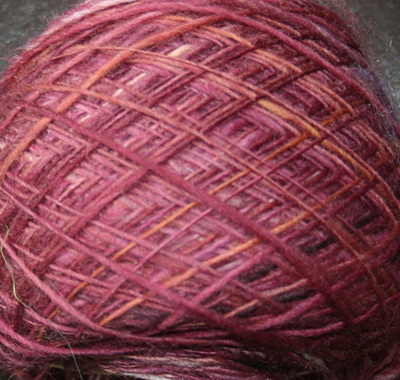Contemplating spinning
for a sweater? Seems like such a huge project
and you’re not
sure you can do it? You can do it and it’s
not as big as it seems. I’m going
to go over some tips and tricks to get you going
and on your way to having a handspun sweater. No,
you don’t have to have a wheel, you can
do this on a spindle.
  The
Card The
Card
Get a piece of paper or a card to make notes
on.
If you are trying to duplicate a certain yarn,
cut a couple of inches and tape it to your paper. Then
spin a sample, this way you have an idea of the
single you need to spin (if you’re doing
a plied yarn). A sample doesn’t
need to be an ounce or anything like that. It
can be a few yards just so you can ply it and
cut a piece to save on your card. Make
sure to label everything clearly.
This is the most structured
thing you’ll
do to work up your sweater yarn and it’s
pretty essential to the project. Even if you’re
going to sit down and spin the whole sweater
at once, it’s good to have this card. The
reason for the card is so that every so
often, you are going to grab it and check it
against the yarn you are currently spinning.
If you are taking a few days to spin the yarn
or a few months (or years), this card will help
you keep the yarn consistently spun. This way
you can work at having the same thickness yarn
throughout the sweater.
For some sweaters,
consistent thickness might not matter too much.
But you really don’t want to start knitting
with a sport weight and finish up with a bulky. If
you hand dyed the roving, you can save that information
on the card as well.

The
Prep
Prepare all your wool before you start to spin.
If you have roving, pre-draft it all. This way
you know that it’s all drafted in the same
way. Pre-drafting makes a huge difference in
the finished yarn. This makes it easy on
yourself. If
you are carding your wool, do it all at once.
Especially if you’re blending. This
will also help to make sure it's all even.
If you are using hand-dyed
fibers, it’s
good to have it all prepped first. Dyed fibers
have variances and if you prep it all at once,
you can make sure one bobbin won’t have
too much of one color and none of another (unless
that’s what you want). Prepping first
will help you make sure your colors are even
throughout.
There is also something
very pleasing about having a large basket full
of fiber ready to go whenever you have time to
spin.
If
you really want to do the prep in different sittings,
and are ok if the colors might get heavy in some
places, write it on your card. Add a sample
of the blend or roving and write notes. You’ll
thank yourself later.
  Numbers Numbers
Number your yarns in the order that you spin
them. I make the little tabs
before I start to spin so they’re
handy when I wind off a cop or a take off a bobbin. I
do this because yarn from the first and
last bobbin/cop can be very different from each
other. Then when I ply, the
first and last yarns are plied together, then
the second and next-to last-together, and so
on in this fashion. It helps to even out the
yarn.
This is most important
if you plan on doing the first bobbin in 2007
and the last one in 2008. Or even if you don’t
plan on it, but you know, life happens. Number
your yarns.
  Cakes Cakes
Many of us don’t have enough bobbins or
spindles to have all this yarn sitting on them
waiting for finishing.
So wind your yarn off as you
go! Cakes of yarn are easier to stack or store.
This is particularly handy
if you’re
prone to start several smaller projects in between
doing a larger one like I do.

Plied
However you have decided is best, go
for it. The plied sample on your card is your
master, so just match your work to it from
time to time. I keep my sample unfinished [that
is, I don’t
soak and set the twist]. Yarn changes a bit
after you set the twist, so if you try to match
a yarn that has already been set when you're
spinning, you won’t
get an accurate yarn.
If you notice my card,
you’ll see the
goal yarn is a little thicker than the plied
sample I have. I tested a piece of that plied
sample by setting the twist. This piece matched
up with my goal yarn so I know that what I
spun is just what I want.

There
you go! Your yarn is done, the twist has been
set and you are ready to start knitting! |

